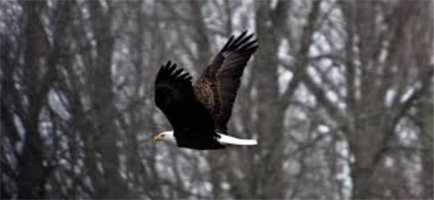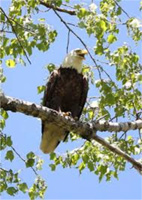Ecology – Bald Eagle


Bald eagles, our national emblem, are one of two species of eagles found in the United States. Their breeding range extends from Alaska and Newfoundland south to Baja California and Florida, although many areas in the interior of the continent have few, if any nesting pairs. As adults, eagles have a chocolate brown body and wings, with their trademark white heads and tail feathers. They also boast a long bright yellow beak with a hooked tip and two inch gray talons protruding from their feather-less toes. At up to 16 pounds (average 12), they have wing spans of six and one half to eight feet. Adult females are much larger than males, averaging 34 to 43 inches in length, while males are only 30 to 35 inches in length. Immature eagles are almost completely brown with irregular patches of white under their wings and tail. Nests are usually constructed near seacoasts, lakes or large rivers to be near their most common food supply: fish. . When fish are not available, such as in winter, eagles will also feed on waterfowl, small mammals (up to rabbit-size) and carrion (even road-kill).
During Michigan winters, bald eagles are seen throughout the state while they nest mainly in the Upper Peninsula and the northern portion of the Lower Peninsula. These eagles don’t really migrate, they just move south enough to stay ahead of the ice and congregate near open water. When bald eagles reach maturity (at four to five years of age), they select a mate, with whom they probably mate for life. In the wild eagles probably don’t reach much more than 20 years of age. The beginning of the breeding season, from mid-February to mid-March, consists of the establishment of a territory, nest building and mating displays. The mating “cartwheel” display begins high in the air with the two birds darting and diving at each other, until they lock talons and drop in a spinning free fall, until the last possible moment when they separate. The nest is usually located in the tallest tree in the area, often a white pine or dead snag. They are usually made of sticks with a lining of grass and moss. Nests may be added to each year until they reach enormous sizes, up to ten feet in depth and 20 feet across.
From late March to early April, one to four (average two) pure white eggs, approximately twice the size of a chicken egg, are laid. Both males and female bald eagles participate in the incubation, and the feeding of the chicks that hatch around seven weeks later. In about three months, by late summer, the fledglings are ready for flight. When it is time to move for the winter, the young birds are abandoned by their parents.
Michigan History
Before European settlement, bald eagles probably nested in all regions of Michigan where food was available. In the early 1900s they were described as being “generally distributed,” but “nowhere abundant.” A decline through the early and mid- 1900s was probably related to slow but consistent loss of suitable habitat and available food, and predator control by humans. These eagles are so disturbed by the presence of humans near their nest that they may be induced to abandon the nest, or even chicks that have already hatched. By 1959, the species was considered, “largely restricted to the northern half of the state.”
Through the 1950s, the slow decline accelerated dramatically, until suddenly, bald eagles were on the brink of extinction in the lower 48 states. The population crash was due to several factors that had reduced reproductive success of nesting pairs, but was mostly the result of increased use of pesticides with chemicals such as PCB and DDT. At its worst in 1967, only 38 percent of the Michigan population of bald eagles were able to raise at least a single chick. Productivity must be at least 70 percent for a bald eagle population to remain stable.
Recognition of the plight of bald eagles in the US and its cause finally occurred in the 1960s. By the 1970s DDT had been banned in the US. Although bald eagles had been protected at federal and state levels since 1940 and 1954, respectively, they received much greater protection after the ratification of the Endangered Species Act in 1973, and the Michigan endangered species act in 1974. The population remained at around 86 nesting pairs through the 1970s. In 1981, the population at last began to increase. The 1999 survey found 343 nests that produced 321 young. The productivity was calculated as 96% (young per nests with known outcomes). But some problems still exist.